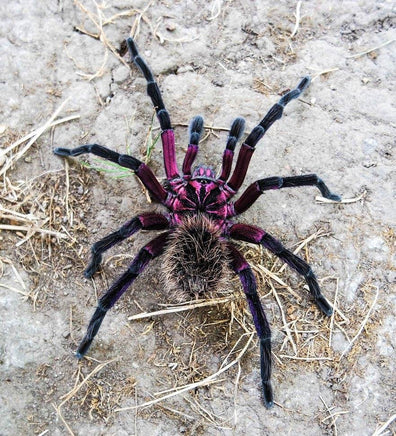
🕷️ Xenesthis sp. "Tenebris" – Monstrosa
***PHOTO is of a MATURE male... females do not look like that. males are more vibrant, but ONLY at sexual maturity. I will get some photos of my females soon ****
Also known as the Colombian Black Flame
This is the darker, moodier sibling in the Xenesthis family—and it lives up to the name Tenebris, meaning “dark” or “shadowy.” Thick, heavy-bodied, with a satin black appearance and an eerie violet-blue underflash on the legs, this species has that perfect combination of mystery and power. Less flashy than Xenesthis sp. "Blue", but every bit as captivating. A true beast once fully grown.
🕸️ Care Details:
- Temperature: 72°F to 78°F is ideal. This species is from high-elevation Colombian forests and prefers slightly cooler temps.
- Humidity: Keep humidity around 75–80%. I use moist substrate with good airflow—avoid waterlogging the enclosure.
-
Housing (Terrestrial species):
- Babies: A 1oz to 4oz deli container with pinhole ventilation is perfect. Ask for one during checkout if you want a free deli cup—if not requested, it won’t be included.
- Juveniles: Use an enclosure 2 to 3 times their size with deep substrate and a cork hide.
- Adults: Minimum 12”x8” enclosure with plenty of floor space. These are big-bodied tarantulas that like to lounge out in the open. I use moss, leaf litter, and bark for a natural look.
🪳 Feeding:
Crickets, Dubia, red runners, hissers—this species eats well and grows steadily.
For babies, I feed small roaches or pinhead crickets.
If prey is too large, crush the head and leave it in—they’ll scavenge with no problem.
An occasional pinky or feeder lizard is okay as a treat, but don’t go overboard. Too much calcium can cause issues during digestion and molting.
🔍 In-Depth Facts:
- Latin name: Xenesthis sp. “Tenebris” (sometimes referred to in hobby as Monstrosa)
- Common names: Colombian Black Flame, Monstrosa
- Locale: Colombia – higher-elevation regions within the Andes, typically humid cloud forests
- Category: Terrestrial – may rearrange substrate but doesn’t burrow deep; usually stays visible
- Size: Females can reach 9 inches +, males slightly smaller and more leggy
- Urticating hairs: Yes—reluctant to use unless stressed
- Growth rate: Moderate, like other Xenesthis—grows steadily with consistent feeding
- Life span: Females 20+ years, males around 3–4 years
- Recommended levels: Great for beginner to advanced keepers, or anyone who appreciates the sheer size and presence of the Xenesthis genus. Moisture control and space are key.
Stay Connected:
- Instagram – See feeding clips and species spotlights
- YouTube – Full care guides and tarantula videos
- Facebook – Read and share your experiences
- TikTok – Quick clips and visuals from the collection
⚠️ Safety Disclaimer:
Experiencing a tarantula bite is an extremely rare occurrence, and it's important to note that there have been no recorded fatalities due to a tarantula bite. The venom potency varies across species, with Old World tarantulasgenerally having stronger venom than their New World counterparts. Within the Old World category, the Poecilotheriagenus is known for having particularly potent venom.
It's crucial to approach tarantulas with respect and understanding. If you happen to get bitten, which is unlikely, the key is to stay calm. In most cases, the discomfort is superficial and subsides within a few minutes to a few hours. However, bites from species with more potent venom may result in symptoms lasting up to a week. Remember, larger tarantulas tend to have more venom than smaller ones.
Please be aware that I cannot assume responsibility for bites. Tarantula handling should be done at your own risk. In my 11 years of experience with these creatures, I have only been bitten once, by a species with highly potent venom. While the experience was painful, the symptoms had completely disappeared after a week.
Handle tarantulas responsibly, and always prioritize your safety and the well-being of the tarantula.